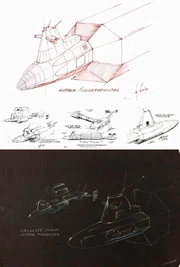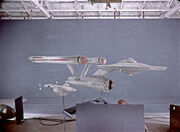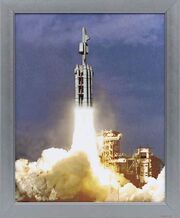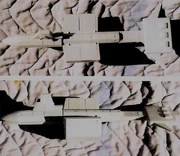The DY-100 class was an early design of Earth space vessels that were in operation during the late 20th century.
History
The ships were especially designed for interplanetary travel. They had simple nuclear powered engines and were equipped with artificial gravity. They utilised transistors as components. DY-100 ships were launched into orbit with booster rockets. In the 1990s, this class of spaceship was considered to be one of the most advanced.
At least some of the DY-100 ships were sleeper ships. In those a crew of at least 85 could be placed into suspended animation inside life support canisters prior to liftoff. The life support of the ship was turned off for the journey. The use of suspended animation was necessary up to approximately 2018, as it took years to travel from planet to planet in the solar system prior to that.
The production of the DY-100 class ship began prior to 1996 and ended some time before the year 2000. A later generation of the class, the DY-500, was similar in configuration and some 23rd century Humans had trouble telling them apart. (TOS: "Space Seed")
A model of a DY-100 appeared on a window sill of the office where Rain Robinson worked, at the Griffith Observatory in California in 1996. She also had a photograph of the launch of a DY-100 attached with tape to a cabinet. (VOY: "Future's End") A photograph of the same DY-100 launch was in the 602 Club, along with many other space achievements, like the NX-Alpha, the Phoenix, and USS Enterprise (XCV 330). (ENT: "First Flight")
Ships commissioned
Template:DYTypeStarships
Appendices
Appearances
- TOS:
- "Space Seed"
- "The Ultimate Computer" (original version)
- VOY:
- "Future's End" (model, photograph)
- "Drone" (computer display)
- ENT:
- "First Flight" (photograph)
- "Home" (photograph)
Background information

Display graphic
All of the DY-100 ships were probably not sleeper ships, as the crew of the Enterprise was surprised to discover the Botany Bay to be one. That contradicts a bit with the computer display of VOY: "Drone", where the image of the ship is specifically labelled "DY-100 Sleeper Ship" (though the graphic might specifically refer to Kahns ship).
It is stated in the Star Trek Chronology that significant improvements in sub-light propulsion technology led to abandoning of DY-100 ships.
The original version of "The Ultimate Computer" featured a DY-100 class Woden as a Federation freighter. This appearance would indicate some of these ships were adapted into service by the Federation and remained in use at least as far as the 23rd century. Due to the retcon of the remastered version it is impossible to determine if this was the case. Memory Alpha lists the Woden as an Template:ShipType starship, for the sole reason it was a more recent appearance from the production point-of view.
In Star Trek Spaceflight Chronology it is stated that DY-100 was the first mass-produced spaceship of Earth. This production began in 1996. There were cargo, fuel and passenger containers the ship could carry. In the standard configuration it was used between Earth and Luna. In an uprated mode it was able to take man to Mars. A journey to Mars, when the suspended animation was used, took 937 days. This is inconsistent with what is established in VOY: "One Small Step". In the Spaceflight Chronology, timeline specifications are given of a SS Copernicus of the DY-100 class. It served from 1995 to 2020. Specification were: length 100 meters, weight 2.72 million kilograms, ship's complement 22, and chemical/fission propulsion. Only the overall shape is similar to the Botany Bay. The Copernicus is probably intended to be the prototype of the class. Unlike the Botany Bay, the Copernicus had a built-in engine pack of six chemical boosters for lift-off. There is a discrepancy with the text and graphics, as the graphics show only four boosters.
Studio models
Design

DY-100 concept art

Template:ShipClass and USS Enterprise studio models filmed at Film Effects of Hollywood
The DY-100 was designed by Matt Jefferies. In sketches it was referred to as an "obsolete tramp space freighter" or an "antique space-freighter." One sketch also included the numbers 418 on the hull of the ship. Jefferies was pleased with the notion of modular shipping crates that could be automatically loaded and unloaded without requiring Humans to venture into space. In the sketches Jefferies envisioned that three additional cargo containers could be attached to complete the middle section arrangement. In fact, judging from the actual model, it appears that even a second set of containers could be attached behind the first. (The Art of Star Trek) In the original script of TOS: "Space Seed", this class was CZ-100. (citation needed • edit)
Physical models
The studio model, measuring 43 x 18 (aft section) inches, was mostly constructed out of wood, as was usual in that era, embellished with miscellaneous model kit parts and metal components. The leading edge of the "sail" (a naval term for the tower structure found on most submarines) features a corrugated metal foil and the engine pod includes metal "antennas" and masts. The model was not internally lighted and was finished in a brown/red-gray hue, though the blue screen filming technique used, washed that finish out into an overall gray on screen, an effect known as "blue spill". While not built by Jefferies, he did add the weathering on the model. Upon completion the model was sent to Linwood G. Dunn's Film Effects of Hollywood where the only footage of the model was shot, its one later appearance as the Woden in "The Ultimate Computer" being stock footage of that shoot.(Cinefantastique, Vol.27, No.11/12, p.70-71)

Launch photo
The table-top model with booster rockets
The table-top model, smaller than the original and outfitted with booster rockets, used in the post-TOS references, first appearing in a photo-shopped launch photograph in the Chronology and subsequently in the Star Trek Encyclopedia was built by Greg Jein. (Star Trek Encyclopedia 3rd ed., p. 52) The launch photo made subsequent in-universe appearances as a wall ornament in VOY: "Future's End", ENT: "First Flight" and ENT: "Home", while the model itself made an appearance in the Voyager episode as a desktop model in Rain Robinson's office. The (framed) photograph itself, part of a set of four, was offered up for auction as Lot #193, in the 40 Years of Star Trek: The Collection auction, estimated at US$200-$300, and was eventually sold on 5 October 2006 with a winning bid of US$3,000 (US$3,600 including buyer's premium).

The table-top model under construction at Jein's shop
SS Botany Bay studio model at the Smithonian
Jein, a life-long Original Series fan, was singularly well suited for constructing the desktop model as he was the owner of the original studio model.Template:Brokenlink Jein had the original model over at his workshop in 1988 for refurbishment, where amongst others he accentuated the brown-gray hull color.[1]. It has made few public appearances, the first time in an early 1990's "Equicon Science Fiction Convention" held in Los AngelesTemplate:Brokenlink and the last time in 1992 when Jein loaned the model to the NASM for their 1992-1993 Star Trek Smithsonian Exhibit and the 1993-1994 follow-up exhibition at the Hayden Planetarium, New York City.[2]
CGI models
The CGI model showing the docking port
For the 2006 remastered version of TOS, a CGI model was built at CBS Digital, by Apollo Kim and supervised by Dave Rossi and Niel Wray. Regarding the remastered version of the Botany Bay, according to Michael Okuda, "...the top of the 'conning tower' now has a tiny circular docking port, very similar to those used on the real-life International Space Station. The docking port was added at the suggestion of a former NASA engineer who noted that a spacecraft built in 1996 would probably have included such equipment to dock at the station." Template:Brokenlink
In 2003 Drexler built a CGI model of a DY-100 class vessel for a fan film in the Star Trek: New Voyages series. His model was later used for the licensed Star Trek: Ships of the Line calendars and their book derivative.[3] A new CGI model was built by former Foundation Imaging employee Jose Perez in 2004 for the "Fleet File" article in Star Trek: Communicator issue 148, pages 62-65.
Apocrypha
In a short story in the 1977 Enterprise Log 4 comic book an unnamed DY-100 class ship was depicted with the registry number FWB 52. The ship was part of a fleet of DY-100 class ships that were used to colonize planets in the Sol system. [4]
External links
- Star Trek History Models and Bluescreen - behind the scenes bluescreen shots of various original series models, including the DY-100
- SS Botany Bay Miniature - photographs of the original model
